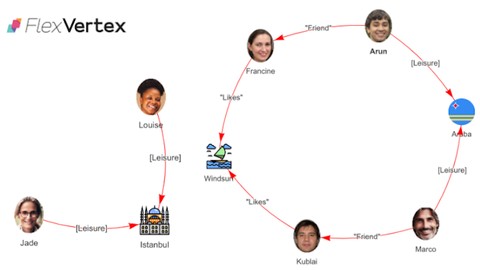
FlexVertex: Graph, Document, K/V, Time Series – One Database
FlexVertex: Graph, Document, K/V, Time Series – One Database, available at Free, has an average rating of 4.6, with 38 lectures, 1 quizzes, based on 3945 reviews, and has 42932 subscribers.
You will learn about Build a flexible data model capable of working with graph, document, key/value, and time-series information Employ object orientation when designing and interacting with your data Learn how AI helps build out the graph, and then graph supercharges generative AI Understand the drivers behind NoSQL technologies Access a live database instance and run the examples Learn the differences between relational and NoSQL data models Implement most major SQL functions, including basic CRUD operations Get your FlexVertex certification This course is ideal for individuals who are Developers seeking to coordinate application and data object orientation or People interested in NoSQL trends or Developers accustomed to relational databases or IT professionals looking for a database that supports multiple models or Architects planning for enterprise-wide generative AI initiatives or People looking to move forward with next generation technology It is particularly useful for Developers seeking to coordinate application and data object orientation or People interested in NoSQL trends or Developers accustomed to relational databases or IT professionals looking for a database that supports multiple models or Architects planning for enterprise-wide generative AI initiatives or People looking to move forward with next generation technology.
Enroll now: FlexVertex: Graph, Document, K/V, Time Series – One Database
Summary
Title: FlexVertex: Graph, Document, K/V, Time Series – One Database
Price: Free
Average Rating: 4.6
Number of Lectures: 38
Number of Quizzes: 1
Number of Published Lectures: 38
Number of Published Quizzes: 1
Number of Curriculum Items: 39
Number of Published Curriculum Objects: 39
Original Price: Free
Quality Status: approved
Status: Live
What You Will Learn
- Build a flexible data model capable of working with graph, document, key/value, and time-series information
- Employ object orientation when designing and interacting with your data
- Learn how AI helps build out the graph, and then graph supercharges generative AI
- Understand the drivers behind NoSQL technologies
- Access a live database instance and run the examples
- Learn the differences between relational and NoSQL data models
- Implement most major SQL functions, including basic CRUD operations
- Get your FlexVertex certification
Who Should Attend
- Developers seeking to coordinate application and data object orientation
- People interested in NoSQL trends
- Developers accustomed to relational databases
- IT professionals looking for a database that supports multiple models
- Architects planning for enterprise-wide generative AI initiatives
- People looking to move forward with next generation technology
Target Audiences
- Developers seeking to coordinate application and data object orientation
- People interested in NoSQL trends
- Developers accustomed to relational databases
- IT professionals looking for a database that supports multiple models
- Architects planning for enterprise-wide generative AI initiatives
- People looking to move forward with next generation technology
The FlexVertex training class is structured to provide a comprehensive understanding of how to design, interact with, and leverage the FlexVertex platform for modern data management needs. The course covers the evolution of NoSQL technologies, the unique features of FlexVertex, and practical hands-on exercises to solidify learning.
### Course Structure and Contents
**1. Course Introduction**
– **Objective**: To understand the drawbacks of legacy NoSQL technologies and discover how FlexVertex addresses these issues.
– **Content**: Overview of FlexVertex’s philosophies, intended audience, prerequisites, and the use case for the exercises.
– **Example Use Case**: A large online travel company similar to Expedia, demonstrating travel reservations, social networking, and credit card applications.
**2. The Rise of NoSQL**
– **Objective**: To explore the reasons behind the rise of NoSQL and its major technologies.
– **Content**: Explanation of what NoSQL is, driving factors for its adoption, and an overview of key/value, time series, columnar, document, and graph databases.
– **Shortcomings**: Discussion on the limitations of NoSQL technologies, including issues with referential integrity, transactions, security, and ease-of-use.
**3. About FlexVertex**
– **Objective**: To introduce FlexVertex and its advantages over first-generation NoSQL technologies.
– **Content**: Details about FlexVertex’s Data Multiverse™, object orientation, pluggable storage, and multi-model capabilities. Emphasis on simplicity, reliability, and extensive support for different data models.
**4. Designing for FlexVertex**
– **Objective**: To learn how to design a FlexVertex database using object-oriented principles.
– **Content**: Definition of classes and properties, implementation of constraints, and creation of connections. Practical examples include designing a class hierarchy, defining properties, and implementing constraints.
**5. Data Operations**
– **Objective**: To master the creation and connection of data objects within the FlexVertex environment.
– **Content**: Detailed instructions on creating data objects, setting properties, and establishing connections. The unit includes exercises to practice these operations on a live instance.
**6. Querying Data**
– **Objective**: To learn how to write powerful and far-reaching queries to unlock the full potential of FlexVertex.
– **Content**: Explanation of query structures and syntax, examples of queries on the sample database, and advanced querying techniques. The unit concludes with exercises to practice querying on a live instance.
### Objectives
By the end of the course, participants will:
1. **Understand the Limitations of Legacy NoSQL Technologies**: Recognize the challenges faced by earlier NoSQL solutions and how they fall short in modern data management scenarios.
2. **Discover FlexVertex’s Solutions**: Learn how FlexVertex addresses the shortcomings of traditional NoSQL technologies with its innovative features and design philosophies.
3. **Design Robust Databases**: Gain the skills to design a FlexVertex database using object-oriented principles, creating a flexible and scalable data management solution.
4. **Populate and Manage Data**: Learn to populate the FlexVertex Data Multiverse™ with various data types and structures, ensuring efficient data management.
5. **Master Advanced Queries**: Develop the ability to write complex queries that leverage FlexVertex’s multi-model capabilities, enhancing data retrieval and analysis.
The course is designed for a diverse audience, including application developers, architects, database administrators, and business users, ensuring that all participants can effectively use FlexVertex in their respective roles.
Course Curriculum
Chapter 1: Course Introduction
Lecture 1: Getting Your Own Private FlexVertex Instance
Lecture 2: Section Introduction and Agenda
Lecture 3: Product Philosophies and Intended Audience
Lecture 4: About the Use Case and Examples
Lecture 5: Example Class Inheritance
Lecture 6: Example Relationships
Chapter 2: The Rise of NoSQL
Lecture 1: Section Introduction, Objectives, and NoSQL Definition
Lecture 2: What's Driving the Move to NoSQL/Major NoSQL Technologies
Lecture 3: Key/Value Databases
Lecture 4: Time Series Databases
Lecture 5: Columnar Databases
Lecture 6: Document Databases
Lecture 7: Graph Databases
Lecture 8: NoSQL Shortcomings
Chapter 3: Designing for FlexVertex
Lecture 1: Section Introduction & Objectives
Lecture 2: FlexVertex & Object Orientation
Lecture 3: Defining Classes
Lecture 4: Defining Properties
Lecture 5: Building a Class Hierarchy
Lecture 6: Defining Constraints
Lecture 7: Connecting Objects
Lecture 8: Live Exercises
Chapter 4: Data Operations
Lecture 1: Section Introduction & Data Objects
Lecture 2: Data Interaction Options
Lecture 3: Creating New Data
Lecture 4: Establishing Connections
Lecture 5: Updating Existing Data
Chapter 5: Querying Data
Lecture 1: Section Introduction and Objectives
Lecture 2: Graph Navigation Complexity
Lecture 3: Voyager Overview
Lecture 4: Voyager Syntax
Lecture 5: Voyager Navigation
Lecture 6: Running the Examples
Chapter 6: About FlexVertex
Lecture 1: Section Introduction & Objectives
Lecture 2: Power: Multiple Models, Object Orientation, Pluggable Storage, and LDAP
Lecture 3: Simplicity: APIs, Voyager, Editions, Deployment, and Portability
Lecture 4: Reliability: Transactions, Containerization, Security, and Open Source
Chapter 7: Course Conclusion
Lecture 1: Course Conclusion Summary
Instructors
-
OrientDB Veterans
FlexVertex: OrientDB reimagined -
FlexVertex Training Team
Your source for FlexVertex training!
Rating Distribution
- 1 stars: 22 votes
- 2 stars: 64 votes
- 3 stars: 489 votes
- 4 stars: 1589 votes
- 5 stars: 1781 votes
Frequently Asked Questions
How long do I have access to the course materials?
You can view and review the lecture materials indefinitely, like an on-demand channel.
Can I take my courses with me wherever I go?
Definitely! If you have an internet connection, courses on Udemy are available on any device at any time. If you don’t have an internet connection, some instructors also let their students download course lectures. That’s up to the instructor though, so make sure you get on their good side!
You may also like
- Best Emotional Intelligence Courses to Learn in March 2025
- Best Time Management Courses to Learn in March 2025
- Best Remote Work Strategies Courses to Learn in March 2025
- Best Freelancing Courses to Learn in March 2025
- Best E-commerce Strategies Courses to Learn in March 2025
- Best Personal Branding Courses to Learn in March 2025
- Best Stock Market Trading Courses to Learn in March 2025
- Best Real Estate Investing Courses to Learn in March 2025
- Best Financial Technology Courses to Learn in March 2025
- Best Agile Methodologies Courses to Learn in March 2025
- Best Project Management Courses to Learn in March 2025
- Best Leadership Skills Courses to Learn in March 2025
- Best Public Speaking Courses to Learn in March 2025
- Best Affiliate Marketing Courses to Learn in March 2025
- Best Email Marketing Courses to Learn in March 2025
- Best Social Media Management Courses to Learn in March 2025
- Best SEO Optimization Courses to Learn in March 2025
- Best Content Creation Courses to Learn in March 2025
- Best Game Development Courses to Learn in March 2025
- Best Software Testing Courses to Learn in March 2025























